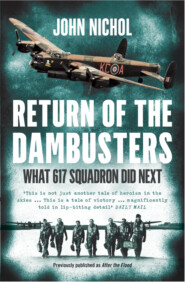
Полная версия:
Return of the Dambusters: What 617 Squadron Did Next



Copyright
William Collins
An imprint of HarperCollins Publishers
1 London Bridge Street
London SE1 9GF
www.WilliamCollinsBooks.com
First published in Great Britain as After the Flood by William Collins in 2015
Text © John Nichol 2015
John Nichol asserts the moral right to be identified as the author of this work.
A catalogue record for this book is available from the British Library.
Cover photographs © Fox Photos/Stringer (men); Shutterstock.com (plane, clouds)
All rights reserved under International and Pan-American Copyright Conventions. By payment of the required fees, you have been granted the non-exclusive, non-transferable right to access and read the text of this e-book on-screen. No part of this text may be reproduced, transmitted, down-loaded, decompiled, reverse engineered, or stored in or introduced into any information storage and retrieval system, in any form or by any means, whether electronic or mechanical, now known or hereinafter invented, without the express written permission of HarperCollins.
Source ISBN: 9780008100315
Ebook Edition © July 2015 ISBN: 9780008100865
Version: 2016-05-18
Dedication
For Sophie
This book is dedicated to all the members of 617 Squadron, on the ground and in the air, who served during the Second World War with such courage and fortitude. Their sacrifice will never be forgotten.
Contents
Cover
Title Page
Copyright
Dedication
Maps
Author’s Note
1. The Dams
2. What Next?
3. Press On, Regardless
4. Death or Glory
5. Spring 1944
6. The End of the Beginning
7. The Fight Goes On
8. Terror Weapons
9. Mac’s Gone!
10. Life and Death on 617 Squadron
11. The Beast
12. ‘What Have You Been Doing Today?’
13. Back to the Tirpitz
14. The Last Christmas?
15. The Final Days
16. Counting the Cost
Picture Section
Notes
Sources and Bibliography
Picture Credits
Index
Acknowledgements
About the Author
Also by John Nichol
About the Publisher
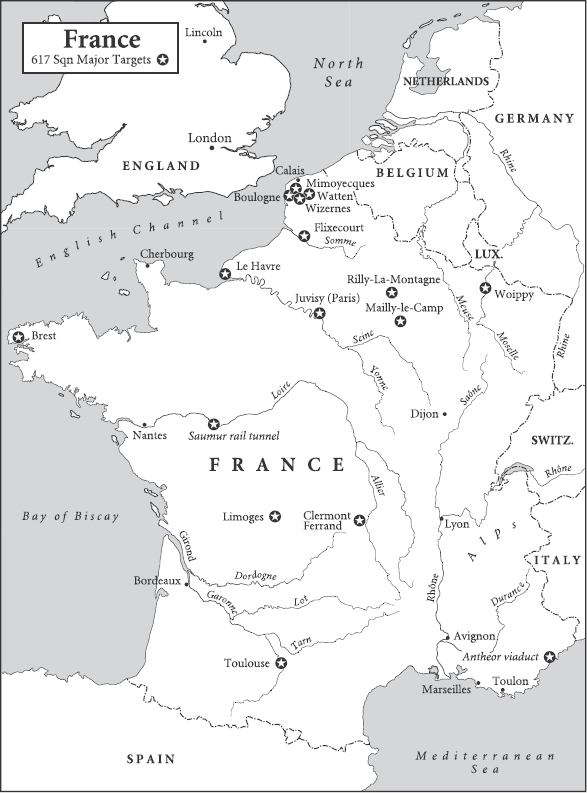

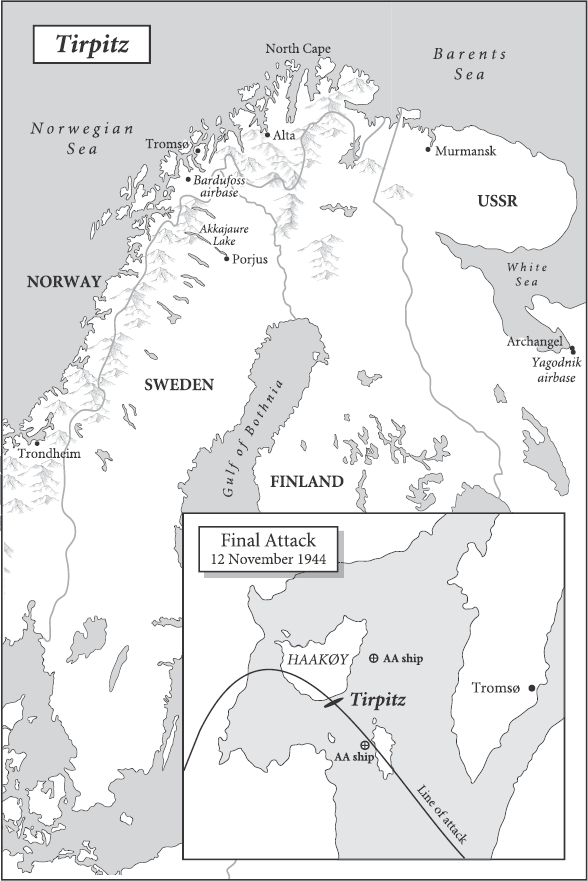
Author’s Note
‘Après moi, le déluge …’
King Louis XV’s last words became the motto of the most famous bomber squadron in history – 617 Squadron RAF – the Dambusters. Their role in Operation Chastise – the attack on the Möhne, Eder and Sorpe dams at the heart of the industrial Ruhr valley on 17 May 1943 – has been celebrated in print and on screen for more than seventy years. But what 617 Squadron did in the aftermath of this iconic raid is far less well known.
617 Squadron was a specialist squadron, formed from some of the RAF’s most brilliant and experienced aircrews for one specific task: breaching the dams. However, British commanders were soon finding other targets for their elite Dambusting squadron, and it was to play the lead role in a series of much less well-known but almost equally eye-catching attacks that destroyed some of the Nazis’ most deadly weapons and wrecked key parts of Germany’s industrial infrastructure.
617 Squadron’s devastating raids caught the imagination, raised the morale of the British public and made headlines around the world. More important, they also helped to tip the balance of hostilities in the Allies’ favour, saved countless thousands of lives and arguably contributed to shortening the war.
CHAPTER 1
The Dams
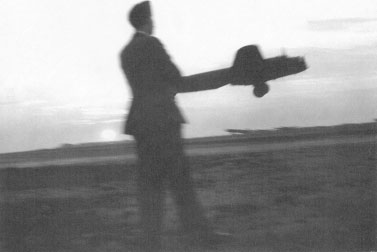
A 617 Squadron Lancaster takes off for the iconic raid on the German dams
During the dark days of 1940, 1941 and the early part of 1942, when the British public had been forced to swallow an unremitting diet of blood, sweat, tears, toil and gloom, the RAF and Bomber Command had offered almost the only glimmers of hope. Despite the propaganda spin, while the evacuation of Dunkirk reduced the scale of disaster, it was a disaster nonetheless. British defeats by the Afrika Korps on the battlefields of North Africa and by the Japanese in the Far East – where the surrender at Singapore on 15 February 1942 was not just the greatest humiliation in Britain’s military history, but the moment from which the end of Empire could be said to have begun – continued the string of military reverses. Only in the air, where RAF Spitfires and Hurricanes had defeated the German bombers in the Battle of Britain and Bomber Command was relentlessly taking the war to Germany’s industrial cities, could Britain be said to be on the offensive.
In late 1942, the victory at the Second Battle of El Alamein ending on 3 November, and the lifting of the Siege of Malta on 11 December, coupled with new tactics at sea which were reducing, though not eliminating, the U-boat menace, suggested the military tide might finally be beginning to turn, but Britain’s commanders and people still looked to the air for proof that Germany was paying the price for its aggression.
A four-month bombing campaign against the cities of the Ruhr, aiming to pulverise and paralyse the heavy industries based there and so to disrupt Germany’s war production, had begun on 5 February 1943 with the bombing of Essen. But arguably, the most crucial targets were the string of dams in the hills flanking the Ruhr. They not only generated some of the power the heavy industries required, but also supplied drinking water to the population, pure water for steel-making and other industrial processes, and the water that fed the canal system on which the Ruhr depended, both to move raw materials to the factories and to carry finished products – aircraft parts, tanks, guns and munitions – away from them.
However, attempts by Main Force – as the squadrons carrying out mass bombing raids in Bomber Command were known – to attack small targets with the required accuracy had so far proved ineffective. Where the requirement was for saturation bombing over a broad area, Main Force could be brutally effective, as the thousand-bomber raid that devastated Cologne at the end of May 1942 had already demonstrated. But regular success in bombing individual targets – particularly if they were as difficult to access and as ferociously defended as the dams – had proved elusive.
Attacks by torpedo bombers like the Bristol Beaufort and the Fairey Swordfish were foiled by a lack of suitable weapons and by heavy steel anti-torpedo nets strung across the waters of the dams to protect them. A more radical solution was needed and the British engineering genius Barnes Wallis supplied it: the Upkeep ‘bouncing bomb’, a cylindrical weapon like a heavyweight depth charge, imparted with backspin to rotate it at 500 revs a minute. If dropped at the right height and distance from the dam, the bomb would skim like a pebble thrown across the surface of the water, bounce over the top of the torpedo nets and strike the dam wall. The backspin would then hold it against the face of the dam as it sank below the water before detonating to blow, it was hoped, the dam apart.
Having demonstrated the theoretical effectiveness of the bomb, all that was needed was a squadron of bomber crews capable of delivering it with sufficient accuracy. Since no such squadron existed, it became necessary to create one – 617 Squadron – and at the end of March 1943 recruitment of suitably skilled and experienced crews began under the leadership of Wing Commander Guy Penrose Gibson. He was a man with a glowing reputation as a fearless pilot, willing to take off in even the most marginal weather and attack the most heavily defended targets, whether capital ships or military or economic targets. The head of Bomber Command, Air Marshal Arthur ‘Bomber’ Harris, later described Gibson as ‘the most full-out fighting pilot’ under his command and ‘as great a warrior as this island ever bred’.
Gibson had flown two full tours on bombers and one on night-fighters, completing the astonishing total of 172 sorties even before joining the new 617 Squadron. As a Squadron Leader and then a Wing Commander, he was as ruthless in screening his crews as he was aggressive in facing the enemy. That ruthlessness and an often abrasive and patrician manner, particularly with NCOs and ‘other ranks’, made him enemies – some of his ground crews nicknamed him ‘The Boy Emperor’ – but none could deny his courage or skill as a pilot, which were reflected by the Distinguished Flying Cross and Bar and Distinguished Service Order and Bar he had already been awarded prior to joining 617 Squadron.
Gibson was given a free hand in choosing men – all volunteers – from among crews who had already completed, or nearly completed, two tours of operations. The screening process continued even after they were chosen; Gibson posted two crews away from the squadron after deciding they were not up to the task and a third crew chose to leave after their navigator was also deemed unsatisfactory by Gibson. Intensive training of the remainder lasted for several weeks. In April 1943 alone, his crews completed over 1,000 flying hours, and at the end of that time Gibson reported that they could fly from pinpoint to pinpoint at low level in total darkness, fly over water at an altitude as low as 60 feet and carry out precision bombing with remarkable accuracy. They practised the raid itself using reservoirs in the Peak District and Rutland as substitutes for the Ruhr dams, and after a full-scale dress rehearsal on 14 May 1943, simulating the routes, topography and targets of the actual raid, Gibson pronounced it ‘completely successful’. The Dambusters – though no one yet called them that – were ready to take flight.
They had been training for six weeks in the utmost secrecy for a low-level bombing mission, but none of them knew the actual targets until the final briefing on the day the raid was to be launched. When they were told, every man in the room felt a stab of fear, ‘and if they said any different,’ says air gunner Fred Sutherland, ‘they’d be lying, because it looked like a real suicide run.’1
They were to target three dams – the Möhne, Eder and Sorpe – and their destruction would cause catastrophic flooding in the Ruhr valley and massive disruption to power generation, water supply, canal transport, agriculture, coal-mining, steel-making and arms manufacturing. If the raid successful.
* * *
On the nights she was not on duty, telephone operator Gwyn Johnson would often lie in bed, waiting in vain for sleep to come. She could sometimes hear the low, grumbling engine note of the bombers of 617 Squadron on their nearby base breaking the stillness of the night as, one by one, each pilot fired up his Lancaster’s four Rolls-Royce Merlin engines and began to taxi from the dispersal areas to the end of the runway. She could picture them waiting until a green light flashed from the runway controller’s caravan, when each pilot in turn pushed the throttles to the stops and his heavy-laden bomber began rumbling slowly down the runway. The noise swelled as one by one they lumbered into the air before finally disappearing into the night, the roar of the engines fading again to a sound like the distant rumble of thunder from a summer storm.
Not knowing whether her husband, Bomb Aimer Sergeant George ‘Johnny’ Johnson, was flying with them on any particular night, she often fell into an uneasy, fitful sleep, and a few hours later, as dawn approached, would wake again as she heard the aircraft return, no longer in a compact formation, but spread across the sky.
Hours later – if he had time – she might meet her husband for a snatched cup of tea in a cafe. He’d tell her if he’d been flying the night before and, though he gave her only the sketchiest details of the mission he’d flown, the look on his face was enough to tell her whether his comrades had returned safely or, more often than not, when one or more aircraft would have failed to return.
Yet, says Johnson, recalling those events seventy years later, ‘Gwyn had the same confidence as me that I would always come back. We both had an absolute belief we would survive.’2 Johnson, a country boy from a small Lincolnshire village with a habit of talking out of the side of his mouth as if all his conversation was ‘hush-hush’ and on a ‘need to know’ basis, was the bomb-aimer in American pilot Joe McCarthy’s crew.
Johnson and the rest of Joe McCarthy’s crew had all finished their thirty-op tour of duty with their previous squadron, 97, two months before the Dams raid, when they took part in a mass raid on the docks at St-Nazaire. ‘I could have called it a day after my thirty ops,’ Johnson says, ‘but I wanted to go on.’ After completing a tour, it was standard practice to be given a week’s leave before returning to duty, and Johnson and his fiancée, Gwyn, had arranged to get married on 3 April 1943, during his leave. They’d met when he was at the aircrew receiving centre at Babbacombe in 1941. He was walking down the street with his mate when they saw two young ladies walking towards them, and Johnson recalls coming up with ‘the corniest chat-up line. I said, “Are you going our way?” to which one of them replied, “That depends on which your way is!” That was Gwyn, that was the start and I never looked back!’
However, the week before the wedding, McCarthy, now the proud holder of a DFC, called the crew together and told them that Wing Commander Guy Gibson had asked him to join a special squadron being formed for a single operation. His crew at once volunteered to go with him for that one trip. The first thing most of the aircrew noticed when they joined 617 Squadron was how experienced most of their fellows were – ‘lots of gongs on chests’ as Johnny Johnson recalls. ‘With all this experience, we were obviously up for something special.’ But he had ‘no idea what 617 Squadron was going to do,’ he says, ‘not a clue,’ but when he wrote to Gwyn and told her he was going on another op, he added, ‘Don’t worry, it’s just one trip. I’ll be there for the wedding.’
Her reply was brief and to the point: ‘If you’re not there on April the third, don’t bother.’
He thought that it would still be fine until they arrived at the new squadron’s base, Scampton, where one of the first things they were told was that there would be no leave for anyone until after the operation. However, McCarthy then marched his entire crew into Guy Gibson’s office and told him, ‘We’ve just finished our first tour; we’re entitled to a week’s leave. My bomb-aimer’s supposed to be getting married on the third of April and he’s gonna get married on the third of April.’
The patrician Guy Gibson didn’t like being told what to do by anyone, least of all an NCO, and an American to boot, but in the end he granted them four days’ leave and Johnson’s wedding went ahead. Wives of married aircrew weren’t allowed to live on base, but Gwyn, a military telephone operator, was posted to Hemswell, eight miles from Scampton, and she and Johnny could meet in Lincoln on their days or evenings off. The last buses for Hemswell and Scampton both left Lincoln at nine o’clock, and Johnson invariably ended up on the Hemswell bus and then had to walk the eight miles back to Scampton. ‘I was one of the few who had a wife close by,’ he says, ‘and it was important for me to get away from the squadron atmosphere to “normal” married life. We never talked about the war and certainly not about any fears or concerns for the future. Our time together was time away from the war.’3
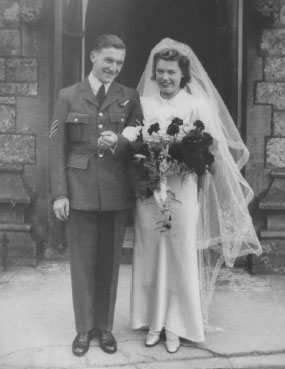
Johnny and Gwyn Johnson on their wedding day
* * *
Johnny Johnson and the rest of Joe McCarthy’s crew were one of nineteen Lancaster crews from 617 Squadron, a total of 133 airmen, who set out for Germany on that ‘one special op’ on the evening of 16 May 1943. At 9.28 that evening, a few minutes before the sun set over the airfield, the runway controller at RAF Scampton flashed a green Aldis lamp. The four Merlin engines of the Lancaster bomber, already lined up on the grass runway, roared up to maximum power and the aircraft thundered into the sky. 617 Squadron was on its way to Germany, and though none of the participants knew it at the time, into the history books.
Two of the nineteen crews turned back even before reaching the enemy coast; one accidentally losing their bomb over the North Sea, another with a flak-damaged radio. Another Lancaster was lost altogether after its pilot, Flight Lieutenant Bill Astell, who like his peers was flying at extreme low level, flew straight into an electricity pylon, killing himself and his entire crew. Sixteen aircraft now remained.
617 Squadron’s leader, Wing Commander Guy Gibson, led the remainder of the first wave to their first target, the Möhne dam. Each crew would have to drop their bomb with total precision, flying at a speed of 232 mph, exactly 60 feet above the surface of the dam. There was no margin of error – dropped from too low an altitude, any water splash might damage the aircraft; too high and the bomb might simply sink or shatter. If dropped too far away, it could sink before reaching the dam; too close, and it might bounce over the parapet.
While the remainder circled at the eastern end of the lake, Gibson began his bomb-run, swooping down over the forested hillside and roaring across the water towards the dam, its twin towers deeper black outlines against the darkness of the night sky. The Upkeep bomb was already spinning at 500 rpm, sending juddering vibrations through the whole aircraft – ‘like driving on a cobbled road’ as one crewman described it.4 Gibson had just fourteen seconds to adjust his height, track and speed before the moment of bomb-release. Alerted by the thunder of the Lancaster’s engines, the German gun-crews of the flak batteries sited in the two towers of the dam scrambled to their battle stations and opened fire. Not a trace of breeze ruffled the surface of the black water, which was so still that it reflected the streams of tracer from the anti-aircraft guns like a mirror, leading Gibson and the pilots making the first bomb-runs to believe there were not three but six anti-aircraft guns firing at them.
At 0.28 on the morning of 17 May 1943 Guy Gibson’s bomb-aimer released his bomb. Gibson banked round in time to see the yellow flash beneath the surface of the water and subsequent waterspout, but as the water splashed down and the smoke dispersed, it was clear that his bomb had failed to breach the dam. He then circled and called in the next pilot, John ‘Hoppy’ Hopgood, nonchalantly describing the task as ‘a piece of cake’. It was anything but. Hopgood’s Lancaster had already been hit by flak as they flew across Germany towards the target, wounding several of his crew and giving him a serious facial wound, but he flew on, pressing a handkerchief against the wound to staunch the flow of blood. Turning to evade the probing searchlight beams, he flew so low that he even passed beneath the high-tension cables of a power line stretching across a landscape as dark as the night sky above them.
As he made his bomb-run, Hopgood’s aircraft was again hit by flak and burst into flames. Although his bomb was released, it was dropped too close and bounced clean over the dam wall. Although it destroyed the electricity power station at its foot, sending a column of thick, black smoke high into the air, it did no damage to the dam itself. Hopgood managed to coax his stricken and burning aircraft up to 500 feet, giving his crew a slim chance of survival, but as he shouted ‘For Christ’s sake, get out!’5 the flames reached the main wing fuel tank, which exploded. Two crewmen did manage to bale out, and survived, to see out the war as PoWs. His badly wounded wireless operator also baled out, but his parachute did not open in time. Hopgood and the other three members of his crew were trapped in the aircraft as it crashed in flames, and all were killed instantly.
The twenty-five-year-old Australian pilot Harold ‘Mick’ Martin was next to make a bomb-run, with Gibson now bravely flying almost alongside him to distract the flak gunners and draw their fire. Martin’s bomb was released successfully, but two flak shells had struck a petrol tank in his starboard wing and, though it was empty of fuel and there was no explosion, the impact may have thrown their bomb off course. As Martin flew on between the stone towers of the dam, the bomb hit the water at an angle and bounced away to the left side of the dam, before detonating in the mud at the water’s edge. However, the force of the mud and water thrown up by the blast dislodged one of the flak guns on the southern tower from its mounting and the gun-crew of the battery in the northern tower were now also forced to change their red-hot gun-barrels.
In the lull in the firing, Melvin ‘Dinghy’ Young – so named after surviving two ditchings at sea – made his bomb-run. His Upkeep was released perfectly, bouncing in smooth parabolas along the surface of the water. It struck the exact centre of the dam and sank deep below the surface before detonating against the dam wall. The explosion sent up another huge waterspout, but once more it appeared to have failed to breach the dam.
The op looked to be heading for a disastrous failure, and the bouncing bombs’ designer, Barnes Wallis, waiting in the operations room back in England – the basement of a large house on the outskirts of Grantham – was almost beside himself as the succession of coded signals came through, announcing the failure of each bomb-run. He had tested his original concept by bouncing his daughter’s marbles across a tub of water, and had endured obstruction and ridicule before his ideas were accepted, but three bombs had already failed, and now the fourth bomb had also been dropped, once more without apparent effect.
Gibson now called up David Maltby, just twenty-three and, like Mick Martin, already the holder of the DFC and DSO. He was the fifth to make his approach, flying in at 60 feet above the water, with Gibson and Martin both acting as decoys to draw off some of the anti-aircraft fire. They even switched on their navigation lights to distract the flak-gunners, while their own forward gunners poured fire into the enemy positions, but although the raiders did not know this, all the anti-aircraft guns had now been put out of action and the gunners could only fire rifles at the Lancaster roaring across the lake towards them.



